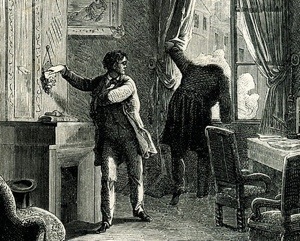Well, we’ve made it to the halfway point, and if you’ve made it this far you know that you’ll be able to make it the rest of the way. 🙂
Below are links to new posts since the last update and also a survey about what you think of the challenge so far and of the stories you’ve read. Participation is optional, but I would enjoy reading some feedback. You can either participate via the comments or via a separate post on your own blog.
James found an easy connection between his stories this week, reading Ernest Hemingway’s “A Canary for One” and Charles de Lint’s “A Tangle of Green Men” http://jamesreadsbooks.com/2014/06/27/strangers-on-a-train-ernest-hemingway-vs-charles-de-lint/
Dale read Truman Capote’s “A Diamond Guitar” http://mirrorwithclouds.wordpress.com/2014/06/26/truman-capote-the-diamond-guitar/
Katherine drew the mustache-less King of Hearts and read the Kevin J Anderson story “Technomagic” which included a nod to the great Arthur C. Clarke. Oh, and another card trick video as well 🙂 http://katenread.wordpress.com/2014/06/28/deal-me-in-week-26-technomagic/
Pour moi, it was another new-to-me author as I read Eric Puchner’s strange story “Beautiful Monsters” https://bibliophilica.wordpress.com/2014/06/28/beautiful-monsters-by-eric-puchner/
Mid-Year Survey:
1. Do you have a favorite story or author so far?
2. What is your major “discovery” from DMI this year? Either from the posts of fellow participants or from your own story roster – or both.
3. Would you participate in the challenge again in 2015?
4. Do you think a weekly wrap-up post is necessary? Would you prefer a monthly wrap-up?
5. Do you have any good ideas for suit “themes” to share for others who might try the challenge again?
6. Have you gotten much of a response from other readers of your blog (other than fellow DMI’ers I mean)?
7. Can you recommend any good resources (on line or otherwise) for those looking to populate their DMI roster?
8. Does DMI rate favorably in comparison with other book blogging challenges in which you’ve participated? Why or why not?
9. What is/are your favorite part/parts about The Deal Me In challenge?
10. Conversely, what do you NOT like about the challenge or what would you change about it?
11. Feel free to add any other general comments.
Thanks for participating!
My answers:
1. I have several. Two that really stood out are Leonid’s Andreev’s “Lazarus” and Katherine Vaz’s “Undressing the Vanity Dolls.” In general, the Russian Authors (“clubs”) that I’ve read have been my favorites.
2. Too many to mention. One that springs to mind immediately is Grace Paley, much lauded by James at JamesReadsBooks. I’ve also enjoyed learning and reading about some of the African Authors at Returning Reader’s blog.
3. Absolutely! 🙂
4. I think I’d prefer a monthly wrap-up (less work for me) or some kind of Linky widget-y thing (where participants would be responsible for linking in their posts), which I don’t think is available for my “free” version of WordPress. Any shared expertise on this possibility would be appreciated.
5. I’ve thought about a classic fairy tales suit a couple times but never did it, since I fear that would be committing too many of my choices to less “meaty” works. I’ve also thought about a “New Yorker Stories” suit since I’m a subscriber. Another idea is a suit dedicated to authors with a local connection; one of the unstated missions of Bibliophilopolis is to support writers in my area. My favorite idea is a suit of stories I learned about from my fellow DMI participants this year.
6. Most seem to think “That’s a great idea.” A few authors that I’ve communicated with really like it too. One even said she might use it for her students.
7. I’m a big fan of library book sales and used bookstores. I pick up a couple cheap anthologies a year at those. I have ample fodder to last the rest of my short story reading life I think. 🙂
8. I’ve basically only done “read-alongs” and in my “completely objective” opinion DMI is much more fun.
9. I love the randomness and “the hand of fate” participating in deciding when I read something. “Strange coincidences” seem to often occur. I also have loved seeing some of the unique playing cards others have pictured and how others have put their own stamp on the challenge, or have come up with their own variants. And Katherine’s sharing the videos of card tricks.
10. I wish I had specifically stated that participants aren’t necessarily “required” to write a post about every story they read. Being committed to a weekly post can begin to feel like a burden. The real goal should remain just reading 52 stories. The more you post about, the better, but you don’t have to post about every one. 🙂
11. I’ve really enjoyed Deal Me In’s becoming a shared experience the past couple years. Was it Oscar Wilde who said that “a pleasure shared is a pleasure doubled?” – sounds like him but I’m not sure…
Mid-year trivia: can you name the movie that included the scene below? (It’s relevant to this week’s wrap-up…)






























